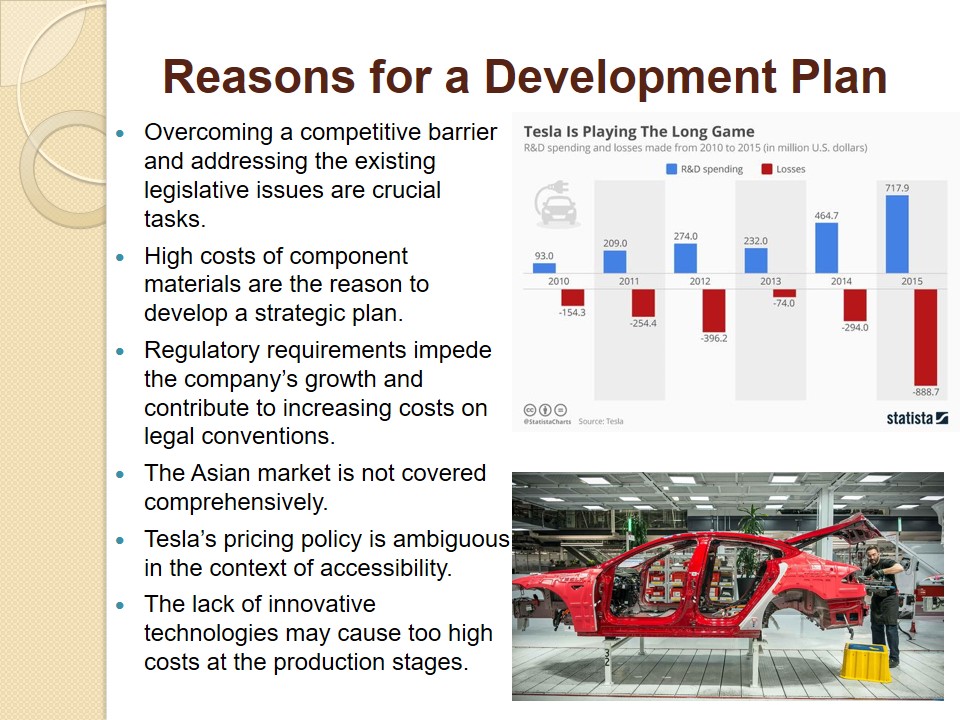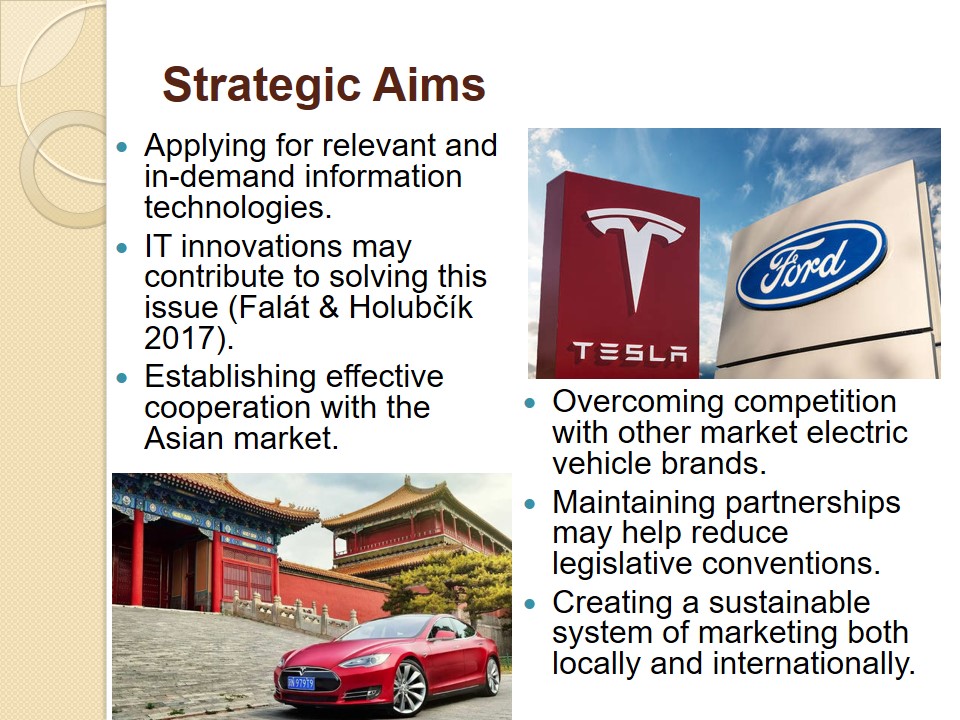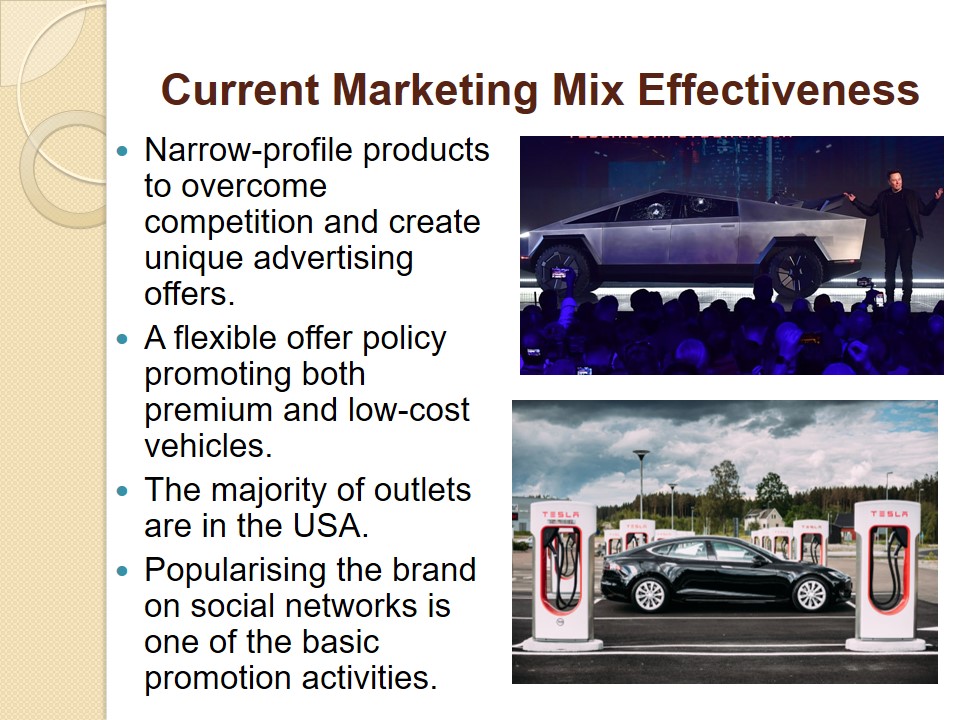Reasons for a Development Plan
- Overcoming a competitive barrier and addressing the existing legislative issues are crucial tasks.
- High costs of component materials are the reason to develop a strategic plan.
- Regulatory requirements impede the company’s growth and contribute to increasing costs on legal conventions.
- The Asian market is not covered comprehensively.
- Tesla’s pricing policy is ambiguous in the context of accessibility.
- The lack of innovative technologies may cause too high costs at the production stages.
To achieve authority in the international market, the Tesla company has to overcome the current competitive barrier and address the existing legislative issues impeding its sustainable growth. It is essential to introduce changes to the internal production processes to reduce the high costs of the production process and minimise the expenses on component materials. In addition, the necessity to enter new markets is a relevant task. To expand the sphere of influence, Tesla needs to interact with the Asian market and represent its products in this region. More opportunities should be provided to consumers to increase brand recognition so that the company’s products could be more affordable because now, Tesla’s goods are expensive. Despite the modern assembly principles, expenses increase due to significant production costs, which, in turn, makes it difficult for the corporation’s marketing specialists to promote the brand

Strategic Aims
- Applying for relevant and in-demand information technologies.
- IT innovations may contribute to solving this issue (Falát & Holubčík 2017).
- Establishing effective cooperation with the Asian market.
- Overcoming competition with other market electric vehicle brands.
- Maintaining partnerships may help reduce legislative conventions.
- Creating a sustainable system of marketing both locally and internationally.
Utilising information technologies may help avoid too high production costs and eliminate expenses at all the assembly stages. According to Falát and Holubčík (2017), addressing the company’s pricing policy due to more accessible offers is a relevant step, and the optimisation of production though implementing productive innovations may help correct the current problems. More favourable terms of sales can enable Tesla’s representatives to cooperate with Asian distributors effectively, which is one of the most important objectives. Using IT innovations in manufacturing can help Tesla create a sustainable background for overcoming competition in this market segment. Strengthening power opportunities through partnerships can not only expand the sphere of influence but also reduce the legislative conventions with which the company has to deal. Achieving brand recognition is possible due to maintaining a sustainable system of marketing, which may help promote the company’s goods in both local and international markets.

Current Marketing Mix Effectiveness
- Sufficiently advanced marketing principles for effective promotion.
- Productive advertising campaigns through different media.
- Engaging new target segments constantly.
- Establishing public relations and brand promotion are the basic activities.
- 4Ps technique may be utilised to assess the effectiveness of brand promotion.
- The criteria of price, place, product and promotion applied.
- Narrow-profile products to overcome competition and create unique advertising offers.
- A flexible offer policy promoting both premium and low-cost vehicles.
- The majority of outlets are in the USA.
- Popularising the brand on social networks is one of the basic promotion activities.
Tesla’s current marketing principles are sufficiently advanced to promote the products of the company successfully. Thus, the brand has become world famous due to effective promoting campaigns through different media, including both traditional advertising sources and modern social networks. Those marketing practices utilised in Tesla are aimed at attracting new target segments constantly and expanding the sphere of influence to increase its profits. The establishment of public relations and brand promotion in the international arena are the company’s key objectives of the current marketing plan. To analyse the productivity of Tesla’s marketing strategy, Falát and Holubčík (2017) offer to use the 4Ps technique to assess the criteria of the effectiveness of brand promotion in the market. The presented methodology includes such criteria as price, place, product and promotion and makes it possible to evaluate how productive marketing principles are in each of these categories.
Tesla’s products are narrow-profile since the corporation offers exclusively electric vehicles and components for them, but in the conditions of demand for the brand, this practice can allow overcoming competition and create unique advertising offers due to the specifics of the corporation’s goods and their advantages over traditional automobiles. Regarding pricing, the corporation’s management has a flexible offer policy since most of the products are premium and nor affordable to many customers; therefore, low-cost models are proposed, as well as bonus programmes. The position criterion is a relatively weak link because the majority of the outlets are located in the United States, and the Asian market is not covered comprehensively. In the promotion strategy, the key emphasis is on popularising the brand on social networks, which is largely achieved by increasing the number of followers of the company’s official groups and the activities of Elon Mask, Tesla’s charismatic leader.


Reference List
Falát, L & Holubčík, M 2017, ‘The influence of marketing communication on financial situation of the company – a case from automobile industry’, Procedia Engineering, vol. 192, pp. 148-153.